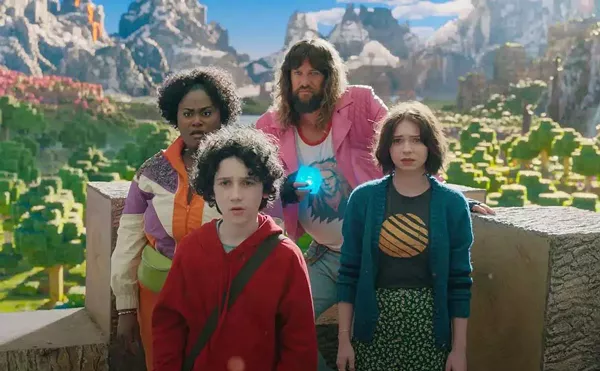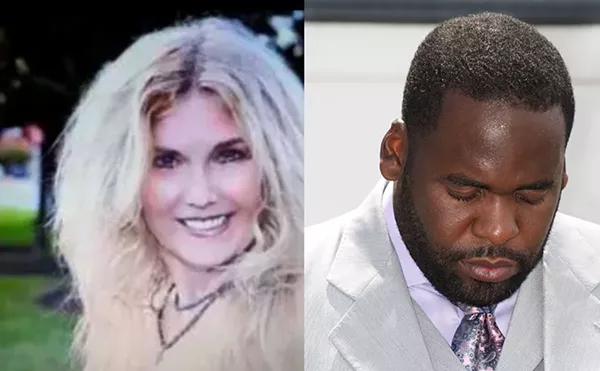The world of the hyperreal is trapped behind the glass walls of the new C Pop Gallery on Woodward. Outside, the street screams its victory – brand-new space, permanent location! – as an exhausted but hopeful neighborhood rises from its cultural ashes, like that lone and beautiful bird of the Arabian desert.
Inside, GI Joe’s gone AWOL (possibly in search of G I Jane) and AWOL’s gone corporate, as the artists – Peter Wardowski, Matthew Zacharias and Gregory Fadell – announce their Mission Statement: "The AWOL Corporation is a team of Information Specialists: creators of comment for commercial, industrial, political, religious, artistic and scientific means. By combining multimedia, surveillance data and marketing strategies, the AWOL staff manufactures imagery with integrity and values for public and private consumption."
Not to worry: AWOL is not in the business of manufacturing consent. Maniacal and glossy, their well-behaved chaos sketches another "short history of the future" inside which the absolute fake masquerades as "the real thing," since "reality" – whatever it may turn out to be – is the only concept capable of soothing a public obsessed by the end of days.
AWOL’s dry, neo-noir humor puts a smile on the face of the disillusioned inside the elegant space of a gallery that refuses to substitute confused clutter for artistic direction. Faithful to the inconvenient, absurdist split suggested by the notion of corporate art, AWOL’s "multimedia mayhem" takes laughter seriously. The "research projects" on the ground floor propose a sinister yet amusing distortion of reality as the protagonists of each scene are little plastic men, figurines of no immediate consequence arrested in "motion" in the middle of a riot or a racy hostage situation.
Postcards from the edge of our postmodern sensibility – but is there such a thing? – AWOL’s photo experiments expand the realm of the hyperreal. Life-like altered states; fleeting images from never-ending stories (a snapshot of Gulliver strapped down by the warriors of Lilliput); stills that send us to the movies of our youth (the bluish silhouette of a piece called "Starlit" reminiscent of The Man Who Fell to Earth) appeal to our often dormant sense of humor. Complimented by the stylized violence of the color prints, the love of geometry suggested by the black and white designs transforms the interior of the gallery into a space of endless possibilities.
Rest assured: AWOL’s surveillance specialists have something in store for all of us, regardless of cultural or professional background. The critic and the artist, the banker and the bum, the student of letters and the mathematician, the victim of kitsch and the defender of realism, the voyeur and the exhibitionist, the psychiatrist and his patient (the garden-variety manic-depressive) can finally share a space: the inside of AWOL’s research laboratory where "reality" is bigger and better than usual, and things appear not as they happened, but as we wish to remember them.
Upstairs, close to the entrance, a member of the AWOL Corporation – a mannequin dressed in a white lab coat, sporting a professional smile and a red balloon – points courteously toward a TV monitor whose screen offers a glimpse into the daily activities of AWOL’s industrious Information Specialists. The uplifting tune which accompanies their mechanical gestures triggers another memory, that of a ridiculously endearing love story between a marketing image consultant and an android in Making Mr. Right. But the reverie ends as soon as we notice the four male mannequins – stand-ins for the lads of "Ace’s High" – posing before the black curtain that divides AWOL’s regular marketing space from the "screening room."
Before the tolerant eye of AWOL’s camera, framed by beer cans and boxes of Benadryl, "Ace’s High" (the band which "favors one member" – Ace Frehley – the lead guitarist of Kiss) tells slow and, at times, inarticulate stories of bewilderment. Their film is followed by a series of shorts, "B-Sides," whose hard-boiled characters – torn between the quotidian and the fantastic flights of their imagination – are destined to travel a lonely road.
Outside the improvised space of the moving pictures, GI Joe’s stern face dominates the back wall, like the remnant of a demented Kuleshov experiment. In the meantime, locked of our own accord inside this gallery of brick and glass, we think of other places of the hyperreal: wax museums, carnivals and fortresses of solitude which speak of "authentic copies" and "immortality as duplication," and force us to experience "the real thing" with a certain degree of sincerity.
E-mail comments to letters@metrotimes.com





